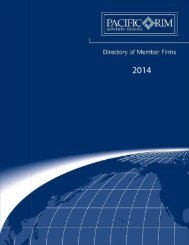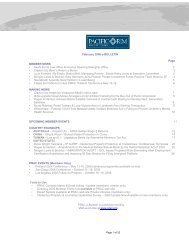A Guide to the Law of Securitisation in Australia - Clayton Utz
A Guide to the Law of Securitisation in Australia - Clayton Utz
A Guide to the Law of Securitisation in Australia - Clayton Utz
- No tags were found...
You also want an ePaper? Increase the reach of your titles
YUMPU automatically turns print PDFs into web optimized ePapers that Google loves.
• Public Trustee Members – for pr<strong>of</strong>essional trustees <strong>of</strong> trustfunds <strong>to</strong> access <strong>the</strong> Austraclear System. Regulation 5.3provides that <strong>the</strong> liability <strong>of</strong> a Public Trust Member <strong>in</strong> respec<strong>to</strong>f transactions and acts or omissions is limited and will notexceed <strong>the</strong> assets <strong>of</strong> <strong>the</strong> trust for which that member istrustee and which is available <strong>to</strong> meet that liability.Regulation 3.5 requires each Member <strong>to</strong> arrange for aParticipat<strong>in</strong>g Bank <strong>to</strong> make payments <strong>in</strong> <strong>the</strong> system on <strong>the</strong>Member’s behalf. Under regulation 1.1 a “Participat<strong>in</strong>g Bank” isa bank or o<strong>the</strong>r entity which is a member <strong>of</strong> <strong>the</strong> Reserve BankInformation and Transfer System (RITS) and Real Time GrossSettlement System (RTGS) and has an exchange settlementaccount with <strong>the</strong> Reserve Bank. The RITS/RTGS is <strong>the</strong> systemowned and operated by <strong>the</strong> Reserve Bank for <strong>the</strong> real time grosssettlement <strong>of</strong> transfers between accounts <strong>of</strong> Participat<strong>in</strong>g Bankswith <strong>the</strong> Reserve Bank.A Member must ma<strong>in</strong>ta<strong>in</strong> a Nom<strong>in</strong>ated Account with itsParticipat<strong>in</strong>g Bank. Pursuant <strong>to</strong> regulation 3.6(b), a Participat<strong>in</strong>gBank is liable for <strong>the</strong> obligations <strong>of</strong> its client Member under <strong>the</strong>Regulations if <strong>the</strong> Member becomes <strong>in</strong>solvent and has failed <strong>to</strong>fulfil its outstand<strong>in</strong>g obligations <strong>in</strong> relation <strong>to</strong> any transactionwhich has been settled by <strong>the</strong> Member through its Participat<strong>in</strong>gBank. Although a Participat<strong>in</strong>g Bank does not guarantee its clientMember’s obligations generally, it does <strong>in</strong> effect underwrite <strong>the</strong>ircreditworth<strong>in</strong>ess <strong>to</strong> o<strong>the</strong>r counterparty Members <strong>in</strong> relation <strong>to</strong>settled transactions.12.4 The relationship between Austraclear and its MembersThe Regulations seek <strong>to</strong> create a multilateral contract betweenAustraclear, its Members and Participat<strong>in</strong>g Banks. Regulation23.3 provides that:“(d) [<strong>the</strong>] Regulations are a valid, b<strong>in</strong>d<strong>in</strong>g and enforceablecontract between each and every Member, Participat<strong>in</strong>g Bankand Austraclear; and(e) <strong>in</strong> contract<strong>in</strong>g pursuant <strong>to</strong> <strong>the</strong> preced<strong>in</strong>g paragraph with eachMember and each Participat<strong>in</strong>g Bank, Austraclear contractsas agent and trustee for each o<strong>the</strong>r Member and each o<strong>the</strong>rParticipat<strong>in</strong>g Bank as well as on its own behalf, so that <strong>the</strong>rights which Austraclear <strong>the</strong>reby has <strong>to</strong> enforce <strong>the</strong>seRegulations as a contract aga<strong>in</strong>st any person will be rightsexercisable on its own behalf as well as on behalf <strong>of</strong> and for<strong>the</strong> benefit <strong>of</strong> all o<strong>the</strong>r members which are Members orParticipat<strong>in</strong>g Banks from time <strong>to</strong> time.”Regulation 23.4 also provides that “unless expressly agreed,nei<strong>the</strong>r Austraclear nor ano<strong>the</strong>r person, by reason <strong>of</strong> [<strong>the</strong>]Regulations, <strong>the</strong> Operat<strong>in</strong>g Manual or any o<strong>the</strong>r documentrelat<strong>in</strong>g <strong>to</strong> <strong>the</strong> System has a fiduciary relationship with, or istrustee for a Member, a Participat<strong>in</strong>g Bank or ano<strong>the</strong>r person”.12.5 What types <strong>of</strong> securities can be lodged <strong>in</strong> Austraclear?Four types <strong>of</strong> securities can be lodged and traded with<strong>in</strong> <strong>the</strong>Austraclear System:• Paper Securities;• Non-Paper Securities;• Euroentitlements; and• Dematerialised Securities.12.5.1 Paper SecuritiesParagraph 1.1(g) <strong>of</strong> <strong>the</strong> Operat<strong>in</strong>g Manual specifies <strong>the</strong> k<strong>in</strong>ds <strong>of</strong>securities acceptable for lodgement <strong>in</strong> <strong>the</strong> Austraclear System asPaper Securities. The Paper Securities which are accepted byAustraclear are set out <strong>in</strong> regulation 1.1 and <strong>in</strong>clude bank andnon-bank negotiable certificates <strong>of</strong> deposit, promissory notes andbills <strong>of</strong> exchange which, <strong>in</strong> each case, meet certa<strong>in</strong> criteria.Representations and warrantiesA Member lodg<strong>in</strong>g a Paper Security <strong>in</strong> <strong>the</strong> Austraclear Systemprovides <strong>the</strong> representations and warranties <strong>in</strong> regulation 7.5.These <strong>in</strong>clude that <strong>the</strong> Paper Security and <strong>the</strong> signaturesappear<strong>in</strong>g on it are genu<strong>in</strong>e and not forged or fraudulent; that<strong>the</strong> Member has, or has a right <strong>to</strong> pass, good and unencumberedtitle <strong>to</strong> <strong>the</strong> Paper Securities; that it is duly drawn, accepted orendorsed as appears on it; and that <strong>the</strong> Member will be liable forany apparent or concealed defects concern<strong>in</strong>g <strong>the</strong> Paper Security.Paper Securities are physically lodged with Austraclear.Regulation 7.8 provides that Austraclear must arrange for allPaper Securities <strong>to</strong> be kept <strong>in</strong> a secure manner and forAustraclear <strong>to</strong> deposit Paper Securities <strong>in</strong> <strong>the</strong> safe-keep<strong>in</strong>gaccommodation provided by it.Lodgement, transfers and Bills <strong>of</strong> Exchange ActWhen a Paper Security is lodged by a Member, Austraclearrecords <strong>the</strong> Paper Security <strong>in</strong> <strong>the</strong> Member’s Security Record. Thelegal title <strong>to</strong> <strong>the</strong> Paper Security rema<strong>in</strong>s with <strong>the</strong> lodg<strong>in</strong>gMember. Austraclear holds <strong>the</strong> Paper Security as bailee for <strong>the</strong>lodg<strong>in</strong>g Member and each subsequent Member <strong>in</strong> whoseSecurity Record it appears from time <strong>to</strong> time.66






